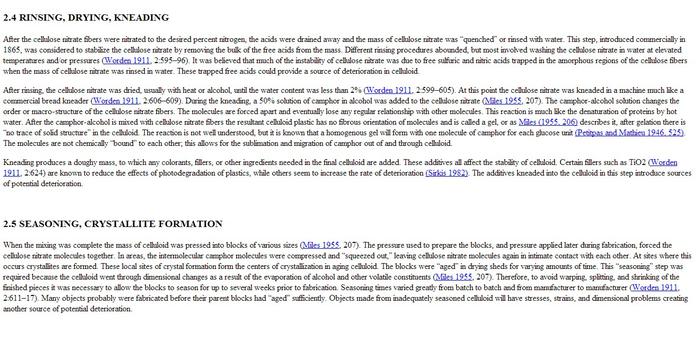Results 1 to 10 of 45
-
06-19-2014, 03:46 PM #1
 Everything You Ever Wanted To Know About Cell Rot (but was afraid to find out...)
Everything You Ever Wanted To Know About Cell Rot (but was afraid to find out...)
***ATTN MODS! Please move to a more appropriate location should you deem necessary.***
***If you are already comfortable with your knowledge level regarding cell rot, please disregard this post.***
While looking for some info to post in another thread, I tumbled across this article from The Journal of the American Institute for Conservation discussing cell rot. I'm going to post the article in its entirety here as the journal is now defunct and has been out of publication since 2005.
This article is without question the most concise yet inclusive discussion of celluloid decomposition, prevention, and preservation I have ever encountered and I believe it to be of great interest to most of us here. For those among us who have little familiarity with illustrations of chemical structures, fear not. The narrative explains all reactions in their entirety in layman's terms, and is much more focused on the processes we are concerned about than it is the chemistry. For those who'd like to cut to the chase, head for sections 2.7-4.4, though maximum benefit from the information is obtained by reading the article in its entirety. If it's hard to read here, please refer to the link.
All credit to Ms. Reilly for this excellent article.
From: JAIC 1991, Volume 30, Number 2, Article 3 (pp. 145 to 162)Last edited by entropy1049; 06-19-2014 at 08:38 PM.
!! Enjoy the exquisite taste sharpening sharpening taste exquisite smooth. Please taste the taste enough to ride cutlery.
Mike
-
-
06-19-2014, 03:47 PM #2

Continuing...








 !! Enjoy the exquisite taste sharpening sharpening taste exquisite smooth. Please taste the taste enough to ride cutlery.
!! Enjoy the exquisite taste sharpening sharpening taste exquisite smooth. Please taste the taste enough to ride cutlery.
Mike
-
The Following 2 Users Say Thank You to entropy1049 For This Useful Post:
Hirlau (06-19-2014), livingontheedge (06-19-2014)
-
06-19-2014, 03:49 PM #3

Finishing...





 !! Enjoy the exquisite taste sharpening sharpening taste exquisite smooth. Please taste the taste enough to ride cutlery.
!! Enjoy the exquisite taste sharpening sharpening taste exquisite smooth. Please taste the taste enough to ride cutlery.
Mike
-
-
06-19-2014, 04:22 PM #4No that's not me in the picture


- Join Date
- May 2013
- Location
- Los Angeles South Bay
- Posts
- 1,340
Thanked: 284
Excellent - thanks so much for this. Like you say, this doesn't read like most journal articles - it's actually understandable to those not in the field
 I love living in the past...
I love living in the past...
-
The Following User Says Thank You to RoyalCake For This Useful Post:
entropy1049 (06-19-2014)
-
06-19-2014, 05:00 PM #5

It's pretty much what we already know, that it's very unstable stuff that can begin to deteriorate from heat, light, UV,exposure to chemicals and physical handling.
No matter how many men you kill you can't kill your successor-Emperor Nero
-
The Following 2 Users Say Thank You to thebigspendur For This Useful Post:
Neil Miller (06-19-2014), rolodave (06-19-2014)
-
06-19-2014, 06:15 PM #6Senior Member



- Join Date
- Apr 2008
- Location
- Essex, UK
- Posts
- 3,816
Thanked: 3164
A nice article, but it has large gaps, eg nothing about celluloe acetate, and like thebigspendur said we already know most of this - in particular I have made a lot of posts that cover more, but people have short memories, alas.
The stuff I have gained from this include mainly the lengthr manufacturing details, but having nitrated cotton wool (cellulose) for my own use and having made collodion from it many tears ago, this is hardly new to me either.
What I find disappointing is what the title of the thread promises but which the article does not deliver. For example, other forms of celluloid, tradenames and timeline of same, why they decided to use camphor and a more detailed explanation of what it set out to do, the use of asbestos filler, an explanation of the breakdown of mottled celluloid describing how the darker, more opaque bits do not breakdown while the lighter transparent colors do, the injection moulding process versus the sheet making process and how allowance is made for shrinkage in the former, a detailed description of howmetal foils and parts were set into presumably injected mouldings to make fancy razor scales, and so on.
A more accurate description for the thread might be "A Few things You Wanted To Know About Celluloid If You Did Not Read Far Int SRPs Archives".
Regards,
Neil
-
06-19-2014, 06:42 PM #7

entropy1049 gets an A for effort.

Below a link to a good article that Randy posted in 2005, and below that the results of a keyword search for "celluloid" in SRP thread titles of the past .......
http://straightrazorpalace.com/gener...html#post10326
http://straightrazorpalace.com/searc...id=2692063&pp= Be careful how you treat people on your way up, you may meet them again on your way back down.
Be careful how you treat people on your way up, you may meet them again on your way back down.
-
The Following 2 Users Say Thank You to JimmyHAD For This Useful Post:
entropy1049 (06-19-2014), Steel (06-20-2014)
-
06-19-2014, 06:59 PM #8Senior Member


- Join Date
- Jan 2011
- Location
- Roseville,Kali
- Posts
- 10,432
Thanked: 2027
Thanks for the post,The old timers may know all that stuff,Thx for the Post Entropy,some good info.
CAUTION
Dangerous within 1 Mile
-
The Following User Says Thank You to pixelfixed For This Useful Post:
entropy1049 (06-19-2014)
-
06-19-2014, 08:28 PM #9

Sorry you didn't enjoy the article as much as I did Neil. As I've been seeing some "Are these scales ok" and "How about this razor" (where the razor in question is suffering from scale rot, I thought it was an excellent, concise, and generally inclusive article that addresses most questions folks unfamiliar with scale rot may have about the condition.
Also, you mention disappointment that the article did not address "an explanation of the breakdown of mottled celluloid describing how the darker, more opaque bits do not breakdown while the lighter transparent colors do". In fact the article does address this in a non-direct fashion in spite of the fact that this was not the topic of the paper:
"Kneading produces a doughy mass, to which any colorants, fillers, or other ingredients needed in the final celluloid are added. These additives all affect the stability of celluloid. Certain fillers such as TiO2 (Worden 1911, 2:624) are known to reduce the effects of photodegradation of plastics, while others seem to increase the rate of deterioration (Sirkis 1982). The additives kneaded into the celluloid in this step introduce sources of potential deterioration." Should you desire to know more, may I suggest Sirkis 1982 (as described in the appendix and source citations).
Additionally, other factors may apply, such as number of nitration sites of the molecule in the polymer chain, and different "recipes" respective of their manufacturers (also discussed in the paper).
Also, your question regarding the choice of camphor as a reagent was indeed discussed:
"camphor substitutes developed by industry include Lindol (Celanese Corp.), which is tricresyl phosphate ortritolyl phosphate; triphenyl phosphate; dehydranone (Union Carbide); and cyclohexyl levulinate. None of these products offered better characteristics than camphor (for less cost). None was used to replace camphor entirely, although small amounts were often added to the celluloid mixture. Worden lists the characteristics that make camphor the best “latent solvent” for cellulose nitrate:
It is an excellent gelatinizing agent of quick and deep penetration, and is an energetic solvent….
It is readily soluble in ethyl alcohol … [methyl alcohol and acetone]….
It has a high melting (175°F) and boiling (204°F) point, and gives, therefore, a solid celluloid,
Its characteristic odor is usually considered as not unpleasant, and it has no cumulative or deleterious effects on the makers and handlers of the celluloid. Furthermore, the volatility is so low as to make loss from evaporation during storage negligible.
It is uncommonly resistant towards chemical agents [nitric acid, acids, alkalis] and does not liberate anything on liquefying which would tend to decompose celluloid….
It reduces the explosibility, but not the inflammability, of cellulose nitrate when mixed with it.
It does not possess a high power of crystallization, and hence does not separate out of celluloid upon heating and subsequent [sic] cooling or upon long storage.
Light has no effect upon it … (Worden 1911, 1:249)."
So it seems we must choose to disagree about the viability of the usefulness of the paper to the layman. I am responsible however for misleading you about the information available in the thread. I will edit the OP to warn the reader that this article addresses cell rot, and not analogous materials, manufacturing processes, injection molding or other chemical and physical properties.
Also-Love your strops!!! Enjoy the exquisite taste sharpening sharpening taste exquisite smooth. Please taste the taste enough to ride cutlery.
Mike
-
06-19-2014, 09:21 PM #10Senior Member



- Join Date
- Apr 2008
- Location
- Essex, UK
- Posts
- 3,816
Thanked: 3164
Thanks, Mike.
What I was getting at was specifics. The article is full of maybes, possiblies, seem to's, and potentials. To much nebulous data, not enough specifics.
As for the camphor, it addresses the question in a lateral way that I don't find helpful. I want to know who thought of adding it, why he thought of adding it, the specific things it solved at that time and why not all cellulose recipes incorporated it. Instead we get a list of the virtues of camphor, which are many and varied - too many and varied to be the reason why someone first thought of incorporating it. There must have been a specific flaw in the manufacture of celluloid that made itself manifest in a very short time - the other main sources of degradation (light, heat, storage, etc) are all time-related and would not have been noticed within a short time - some of them have taken 50 or more years to materialise and become known as a problem. Knowing what that flaw was and why camphor was used as a specific item to address it - now that would have been interesting.
I would follow your lead and find out more a la Sikris et al, but I have enough information about the theory - what i need is something that deals with the practicalities.
And I do agree with you about the number of questions lately about this subject - all of which could have been addressed by a bit of self-help and reading the archives.
There seem to be so many posts from new guys along these lines, all amounting to asking someone else to do their work for them, that I despair. Without the urge to solve problems and work at something we are losing a valuable resource and witnessing the rise of a load of dunderheads, dunderheads that post stuff like 'what do you think of my new razor can you tell me about it, sorry I can't post photos - it hasn't arrived yet' - that makes my blood boil. You research something first, not after if you have any sense, and then you show a modicum of patience to at least wait until it arrives and make a few enquiries yourself.
I guess I'm just getting old. And I don't like it.
All the Best,
Neil
Nothing personal intended with regards to you, Mike.
For the layman, especially our type of layman who is interested in celluloid, this is not a very helpful article.


 50Likes
50Likes LinkBack URL
LinkBack URL About LinkBacks
About LinkBacks







 Reply With Quote
Reply With Quote

